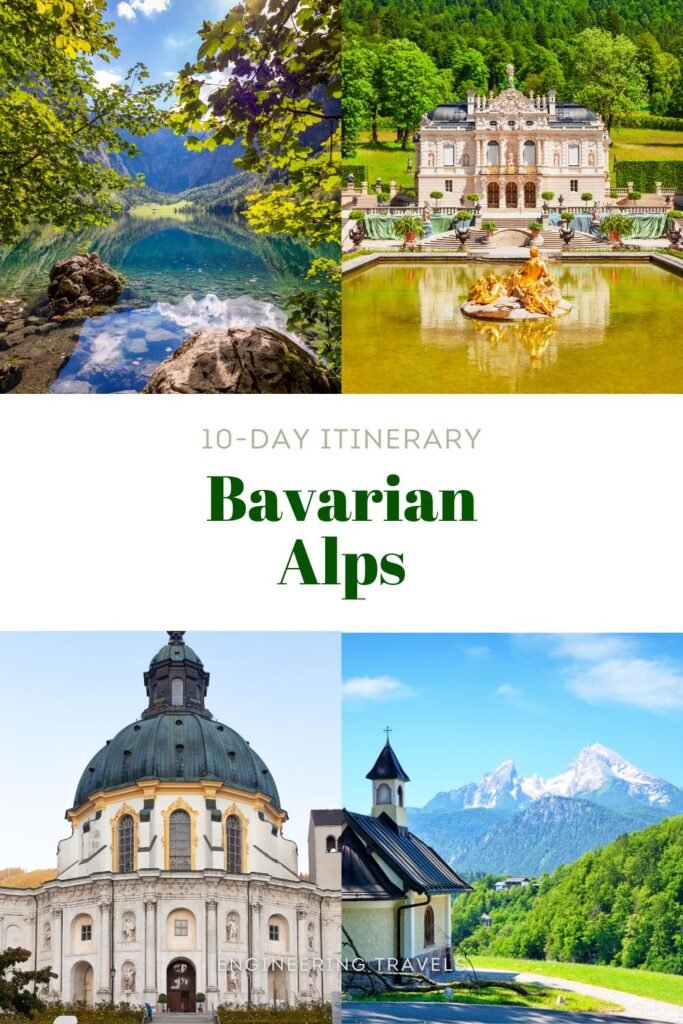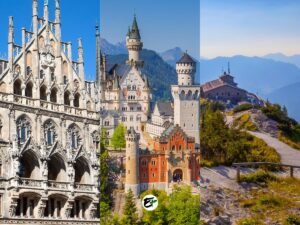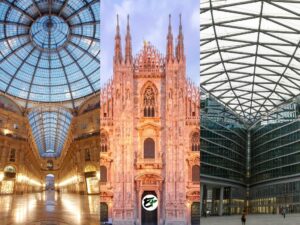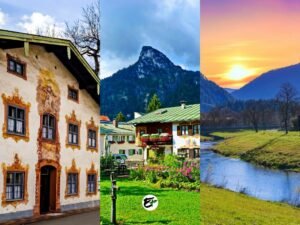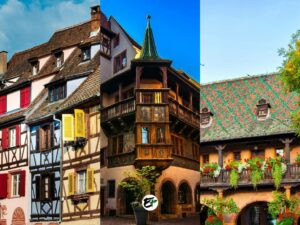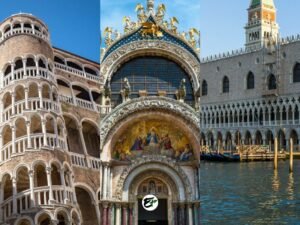10 Days in the Bavarian Alps Itinerary (The Highlights)
In just 10 days, you can explore the highlights of the Bavarian Alps. This includes a visit to five distinct towns and more than a dozen tourist attractions within the Bavarian Alps. Some of these are the country’s most iconic landmarks and impressive natural attractions. These include Neuschwanstein Castle, Eagle’s Nest, Linderhof Palace, Zugspitze, Eibsee, Konigssee, and more.
There are numerous ways to spend 10 days in the Bavarian Alps. However, if you want an itinerary that is designed to minimize travel time between destinations and maximize the time spent at each location, consider this 10-day Bavarian Alps itinerary. Most importantly, this itinerary focuses on the best experiences that the Bavarian Alps has to offer. This makes it ideal for first-time visitors.
The journey begins in Munich and then proceeds to the attractions in the Bavarian Alps from west to east. You’ll visit the Neuschwanstein Castle in Hohenschwangau and explore Garmisch-Partenkirchen and its surrounding areas like Zugspitze and Mittenwald.
Finally, you’ll end up in Berchtesgaden, which is close to Salzburg. From there, you can fly back home or continue on another wonderful journey inspired by the movie, The Sound of Music.
This post contains affiliate links. I may receive a tiny commission at no additional cost to you.
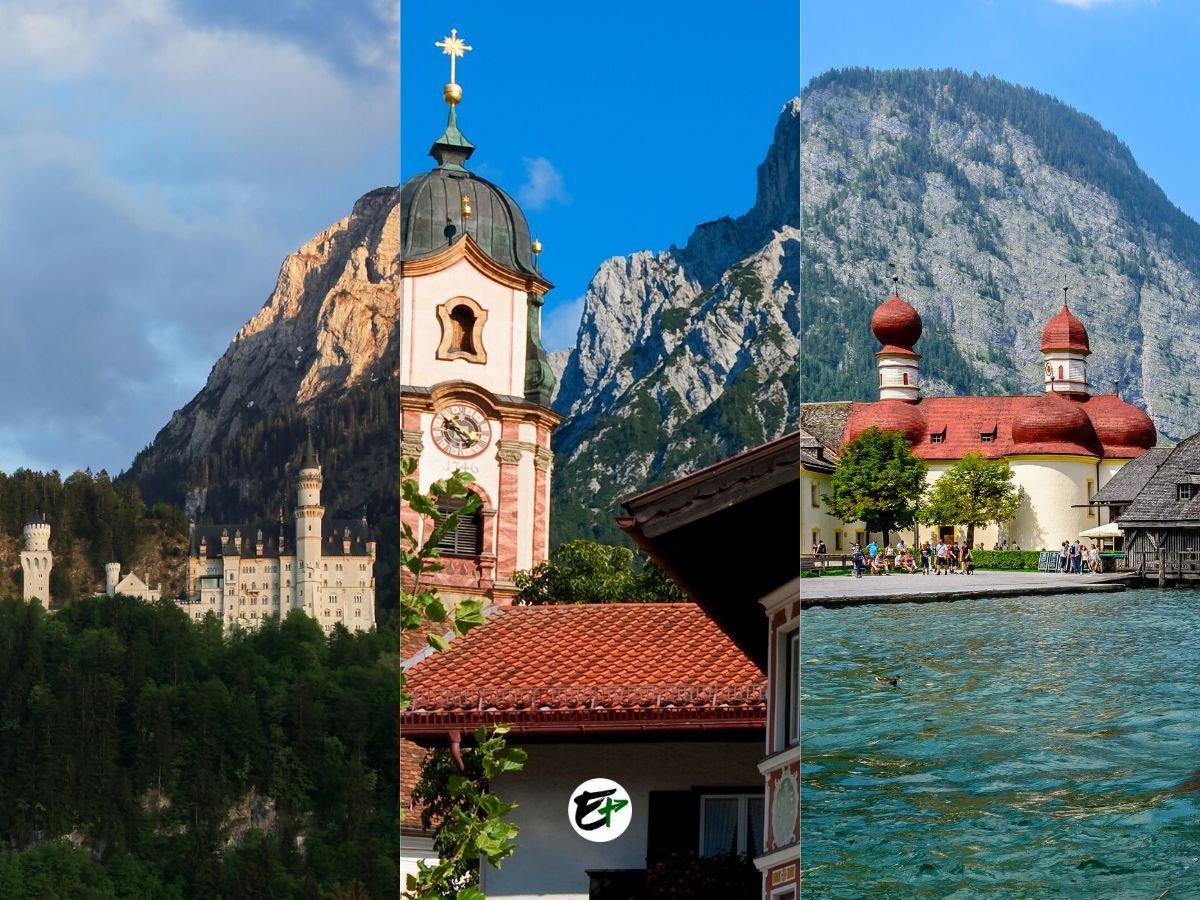
Use the table of contents to skip to topics.
While you could potentially use Munich as your home base and visit each attraction in the Bavarian Alps on a day trip, I wouldn’t advise this. The reason being, you’ll end up spending more time commuting between locations than actually exploring them.
Take Neuschwanstein Castle and Berchtesgaden as examples. A round trip to these destinations would likely take over 3 hours of driving or more than 4 hours on public transportation. Simply put, it’s not practical.
That’s why we’re going to establish multiple home bases for this 10-day Bavarian Alps trip. Specifically, these will be Munich, Garmisch-Partenkirchen, and Berchtesgaden. From these cities and towns, you’ll have quicker access to more attractions in the Bavarian Alps. This approach will save you hours of travel time, allowing you to fully enjoy the attractions.
- Munich — Day 1 and Day 2
- Garmisch-Partenkirchen — Day 3 to Day 7
- Berchtesgaden — Day 8 to Day 9
You can find the best hotel deals in Bavarian Alps here.
The majority of attractions in the Bavarian Alps, as outlined in this itinerary, can be reached using public transportation. However, there are certain segments of this trip where the convenience of a car might be preferable. This is to avoid the stress of keeping up with the limited bus service in some areas. For instance, on Day 6, both Ettal Abbey and Linderhof Palace are serviced by buses. However, these buses don’t run frequently.
To make your trip easier, think about using a car service or hiring a car. For this itinerary: you’ll only need a car from Day 3, after you leave Munich.
IMPORTANT: This Bavarian Alps itinerary is optimized for non-winter months. And if you need a shorter Bavarian Alps itinerary, I got you covered:
Day 1: Munich
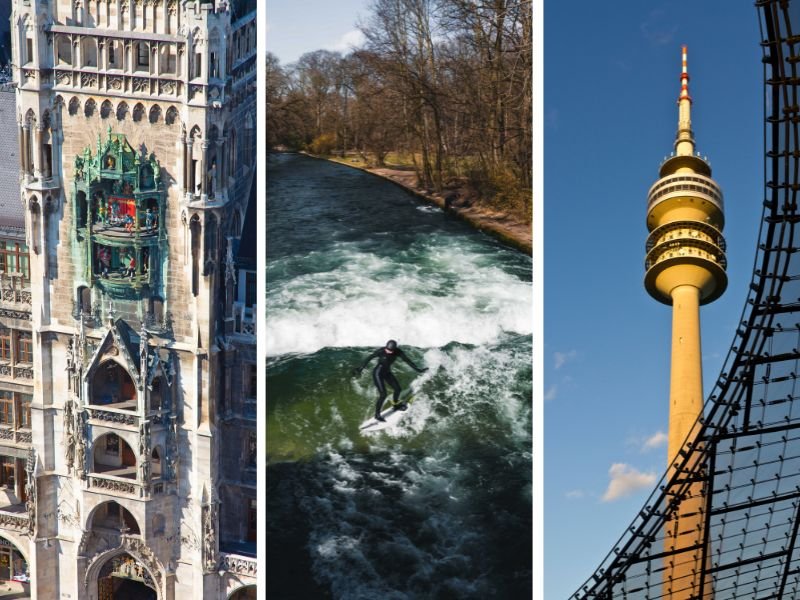
Munich, the gateway to the Bavarian Alps, is an ideal starting point for your journey, especially with its convenient direct flight connections. As the largest city in Bavaria, Munich offers a wealth of travel services to assist you in navigating the region. Whether you need to purchase a SIM card, shop for mountain-appropriate clothing, or rent a car, Munich has you covered.
Once you’ve made the necessary preparations, it’s time to immerse yourself in the city. Munich, the vibrant capital of Bavaria, is steeped in history and culture. Munich has many more beautiful places to explore. Its stunning architecture, museums, galleries, and monuments are a testament to its rich heritage.
A visit to Marienplatz, the heart of Munich’s Old Town, is a must. Here, you can admire the architectural marvels of the New Town Hall and the Church of St. Peter. The New Town Hall and St. Peter’s Church offer breathtaking views of Munich’s cityscape from their towers.
For a unique experience, don’t miss the city surfers at the Eisbach wave in the English Garden. This artificial narrowing of the river Isar offers a sight unlike any other, particularly when you see the surfers do their trick. As the day draws to a close, make sure to visit one more of Munich’s viewpoints. If time permits, the Olympic Tower, Bavaria’s second highest building, provides a panoramic view of the city and the Alps in clear weather.
The sights from the viewpoints serve as a visual appetizer for the exciting attractions you’ll be visiting in the Bavarian Alps in the coming days. If you’re looking for a quick and effortless tour of the city, consider joining a guided tour.
Day 2: Neuschwanstein & Hohenschwangau Castle
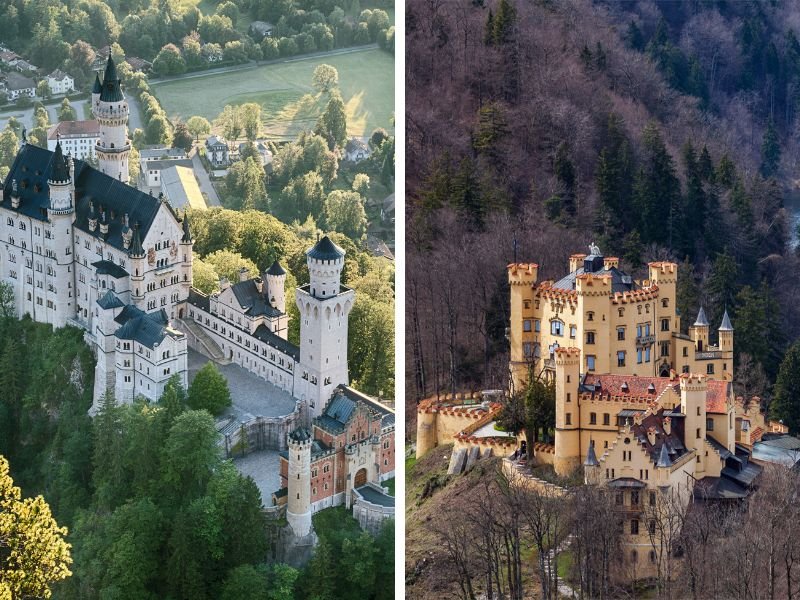
On the second day of your 10-day journey through Bavaria, we set off for Neuschwanstein Castle. This stunning castle is one of Germany’s most beautiful and is well worth the day trip from Munich. Right next to Neuschwanstein, you’ll find Hohenschwangau Castle. This older, smaller castle is just as captivating.
Both of these architectural wonders are steeped in history. As you explore, you’ll feel as though you’ve stepped back in time. Neuschwanstein Castle, perched on a rugged hill above the village of Hohenschwangau, is the star attraction. This 19th-century historicist palace is so enchanting, it even served as the inspiration for Disney’s Sleeping Beauty castle.
As you explore their opulent interiors, you’ll be transported to the world of King Ludwig II, whose eccentric creativity is evident in every corner. Don’t miss the guided tours inside the castles. They offer fascinating insights into the life of King Ludwig II and the history of these magnificent structures.
For a unique experience, pay attention to the cafeteria area in Neuschwanstein Castle. Here, you can spot sketches, steel bars, and other traces of the castle’s unfinished construction.
And if you’re looking for breathtaking views, make your way to Marienbrücke, or Mary’s Bridge. From this vantage point, you can enjoy panoramic views of Neuschwanstein Castle, the beautiful Alpine lake, and Bavaria’s largest nature preserve.
I have a separate post about these places. It also includes other attractions around Neuschwanstein Castle. This will help you make the most of your trip.
If it’s your first time in Neuschwanstein Castle and you’re visiting during the Bavarian Alps during the summer, I recommend joining a group tour from Munich. Often, they offer skip-the-line access to the castle so you may not worry about queueing for minutes, making the most of your visit, and especially finding a vacant slot among the limited parking spaces if you’re driving.
Day 3: Garmisch-Partenkirchen
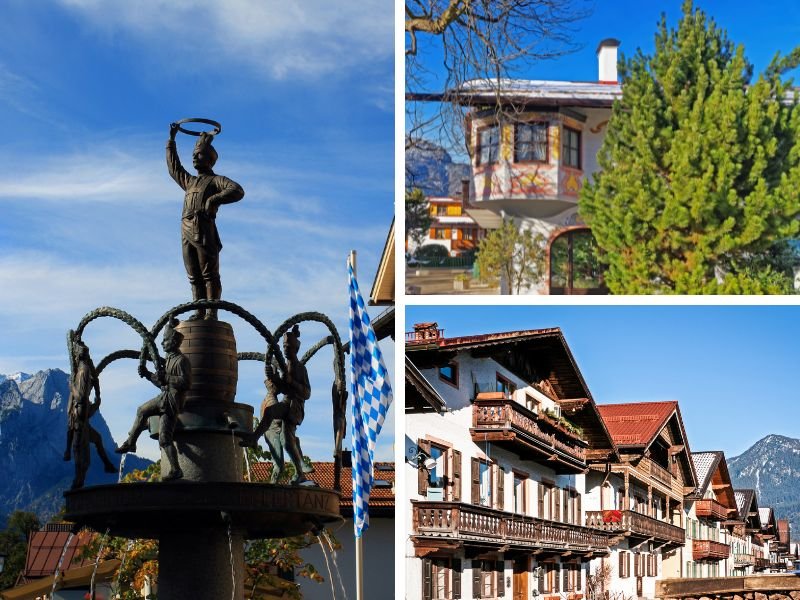
On the morning of the third day of your 10-day Bavarian trip, it’s time to bid farewell to Munich. But before you leave, make sure to pick up some souvenirs!
Old Town Munich is filled with souvenir shops where you can find a variety of keepsakes. Hauptbahnhof also has some great options. However, if there’s one shop you should definitely visit, it’s Herrmann Geschenke. This shop has been offering traditional, high-quality gifts and keepsakes for about 60 years.
Your next stop after Munich is the charming town of Garmisch-Partenkirchen, often referred to as GaPa. It’s just an hour’s drive or a two-hour train ride from Munich. As one of the largest towns in the heart of the Bavarian Alps, GaPa offers plenty of accommodations, restaurants, and amenities, making it an excellent base for exploring the area.
From GaPa, you can easily access attractions like Eibsee, Zugspitze, and the quaint villages of Mittenwald and Oberammergau. However, I wouldn’t recommend heading out just yet as you arrive. Take some time to explore GaPa itself first. The town’s charm is one of the reasons Garmisch-Partenkirchen is such a worthwhile destination.
Start by wandering through GaPa’s scenic streets, such as Ludwigstrasse, and make sure to visit the Parish Church of Saint Martin. You’ll find the village houses adorned with murals, adding an artistic touch to your exploration.
If time permits, consider visiting the Olympic Ski Jump in town. This facility, used in the historic 1936 Olympic Winter Games, symbolizes the unification of Garmisch and Partenkirchen.
Day 4: Eibsee and Zugspitze

Day four of your ten-day Bavarian adventure takes you to two of the most renowned natural attractions in the Bavarian Alps: Eibsee and Zugspitze. As you’re already in Garmisch-Partenkirchen, reaching these destinations is straightforward.
First, let’s talk about Eibsee. This enchanting lake, located southwest of Garmisch-Partenkirchen, is a highlight of the Bavarian Alps. Known for its crystal-clear, emerald-green waters, Eibsee sits in a picturesque setting at the foot of Zugspitze. It’s the perfect spot for both adventure seekers and those looking for a peaceful retreat, offering breathtaking mountain views and a range of outdoor activities like hiking and kayaking.
Next up is Zugspitze, Germany’s highest peak. Towering at an elevation of 2,962 meters (or 9,718 feet) above sea level, Zugspitze is a must-visit. From Zugspitze you can see Germany’s two largest glaciers and visit the country’s most elevated beer garden.
The reason Eibsee and Zugspitze are scheduled for the same day is their proximity. After visiting Eibsee, you can head straight to Zugspitze (vice versa).
From Garmisch-Partenkirchen to Eibsee, you can drive for about 10 minutes along Eibseestraße if you have a car. Alternatively, public transport options like trains and buses are available. The journey from Eibsee to Zugspitze is an adventure in itself. You can take the Eibsee-Seilbahn cable car, which takes you to the peak in just 10 minutes.
If you prefer a slower pace to get to Zugspitze, consider the train. Starting from Garmisch-Partenkirchen, it passes through Grainau and Eibsee before ascending Zugspitze using cogwheel power. This route takes you through a tunnel to the Zugspitze Glacier Plateau, also known as Zugspitzplatt. From there, you can board the Glacier Cable Car to reach the peak.
For the most up-to-date details, I recommend visiting the official websites of Eibsee and Zugspitze. These sites provide the latest information for visitors.
Before you ascend Zugspitze, it’s a good idea to check out the live camera feed. This will give you a real-time view of the conditions at the top of the mountain, helping you decide if the journey to the summit is worthwhile.
Day 5: Mittenwald, Karwendel and Leutasch Gorge
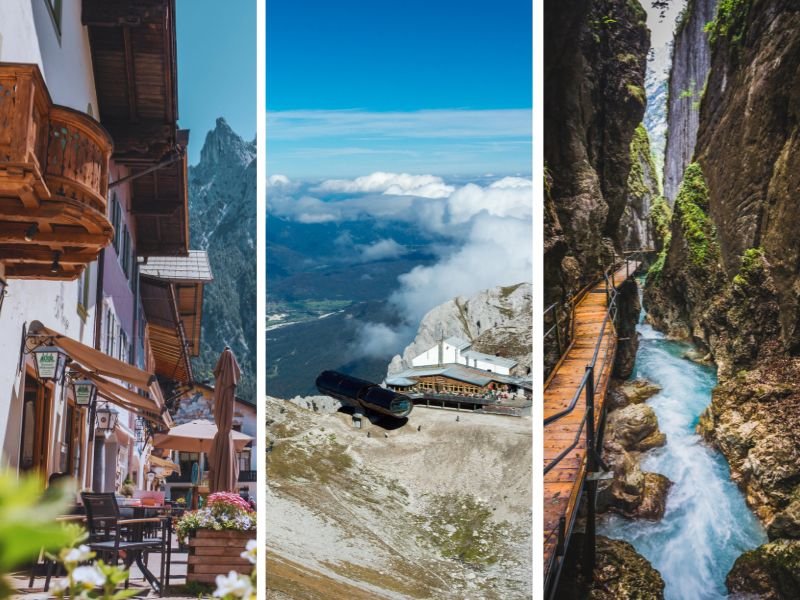
The Bavarian Alps are not just about mountains and lakes. They’re also home to charming villages like Mittenwald. Situated to the east and in close proximity to Garmisch-Partenkirchen, Mittenwald is a village that will capture your heart. Getting to Mittenwald from Garmisch-Partenkirchen is a breeze. Just hop on a train and you’ll be there in no time.
What makes it special? The houses here are adorned with vibrant murals known as Lüftlmalerei. This unique feature adds a splash of color to the village, making it a must-visit destination during your trip to the Bavarian Alps.
Although it’s just a small village, I was surprised to discover that Mittenwald has several amazing things to do. Mittenwald was even once renowned for violin making! There’s a violin museum nestled in the heart of the village that you can visit if you like.
But there are two attractions in Mittenwald that I highly recommend. The first is the Karwendel cable car. The second is the Leutasch Gorge. Make sure you don’t miss these when you visit the village! Let me introduce them to you.
The Karwendel cable car, or Karwendelbahn as it’s known locally, is a real highlight in Mittenwald. It whisks you up to the Karwendelspitze peak, standing tall at 2385 meters above sea level. The journey itself is an experience, with stunning views of the Isar valley unfolding as you ascend.
There, you can also find the Bergwelt Karwendel, an information center right next to the top station. It’s Germany’s highest exhibition about environmental issues, with a focus on the fragile ecosystem of the Karwendel range.
The Leutasch Gorge, nestled near Mittenwald and Unterleutasch on the Bavarian-Tyrolean border, is another sight to behold. It’s a dramatic landscape where the Leutascher Ache river carves its way through steep cliffs.
The gorge is steeped in local folklore, with tales of spirits and ghosts adding a touch of magic to your visit. With its blend of adventure, mystique and tranquility, the Leutasch Gorge promises an experience like no other.
Day 6: Ettal Abbey & Linderhof Palace
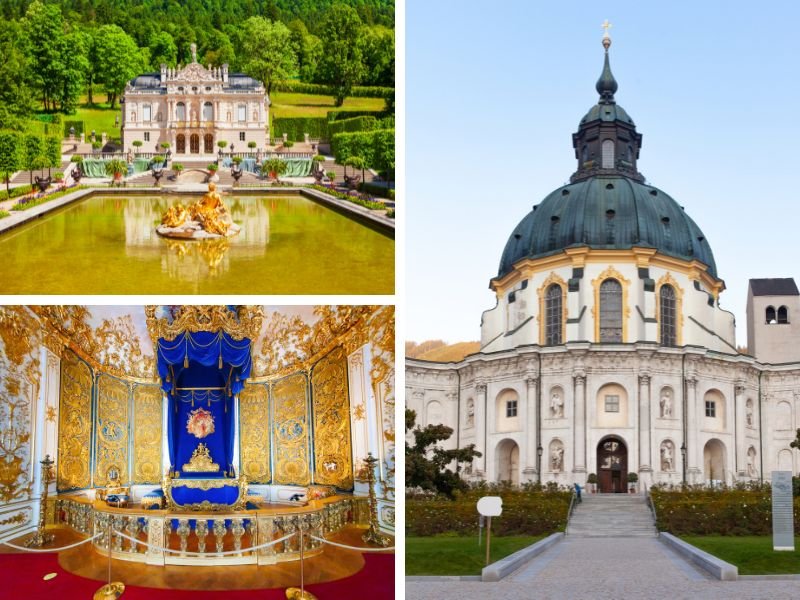
One of the great things about the Bavarian Alps is the range of experiences it offers. As you embark on the sixth day of your trip, you’re about to discover just what that means. Two attractions, in particular, stand out: Ettal Abbey and Linderhof Palace. These places add an amazing “twist” to your journey through the Bavarian Alps. So, get ready for an exciting day ahead!
Ettal Abbey, nestled in the village of Ettal in Bavaria, Germany, is a Benedictine monastery that has been standing since its foundation by Emperor Ludwig the Bavarian in 1330. Today, it is one of the largest Benedictine houses, home to a community of over 50 monks.
What makes it a must-visit destination is its stunning architecture, which is considered one of Bavaria’s architectural highlights, attracting visitors from all over the world. You can check Ettal Abbey’s official website to see what experiences they offer.
On the other hand, Linderhof Palace, nestled in the beautiful Graswang Valley in southwest Bavaria, is a gem among King Ludwig II of Bavaria’s creations. Despite being the smallest of his three palaces, it’s the only one he saw completed.
To me, Linderhof Palace’s allure lies in its stunning second rococo-period architecture and its tranquil, remote location, making it another must-see in the Bavarian Alps. Learn more from Linderhof Palace’s official website.
Ettal Abbey and Linderhof Palace are conveniently located close to each other, making them an ideal day trip from Garmisch-Partenkirchen. Interestingly, both are situated in the same locale, Ettal.
How can you get to Ettal Abbey and Lirdenhof Palace? From Garmisch-Partenkirchen, a short 15-minute car ride or a 30-minute journey on bus #9606 will bring you to Ettal Abbey. Once you’ve explored Ettal Abbey, Linderhof Palace is just another 15-minute drive or a 30-minute bus ride away on bus #9622.
To return to Garmisch-Partenkirchen from Linderhof Palace using public transportation, you’ll need to take bus #9622 back to Ettal Abbey. From there, hop on bus #9606 to Oberau, and then catch a train to Garmisch-Kirchen.
For the most accurate bus schedules, it’s recommended to visit the Regio Bus Bayern website.
Day 7: Oberammergau & Alpine Coaster
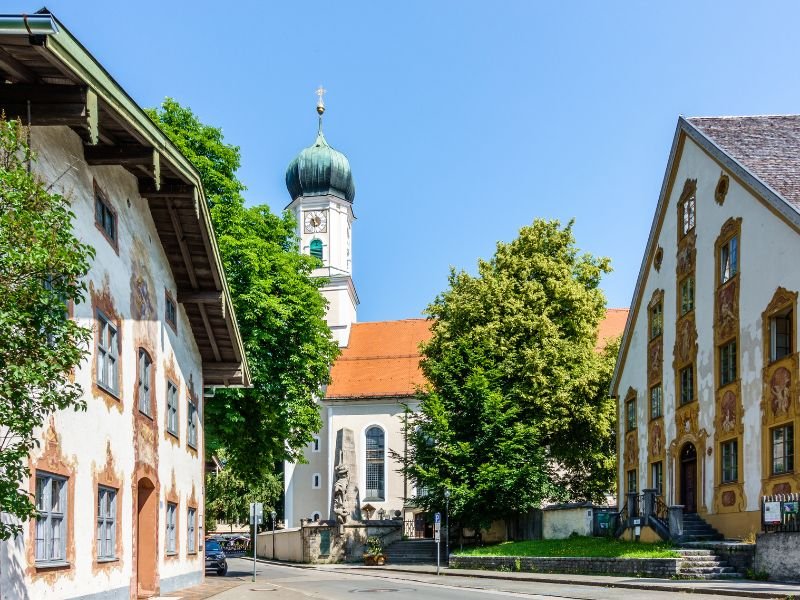
Day seven of your 10-day Bavarian Alps journey promises a blend of adventure and fascinating discoveries. You’ll be visiting Oberammergau, a lesser-known gem in the Bavarian Alps that’s rich in history and culture. From your base in Garmisch-Partenkirchen, Oberammergau is just a 20-minute drive or a 40-minute bus ride away on the direct #9606 route.
Oberammergau is most renowned for the Passion Play, a once-in-a-decade spectacle performed by the locals. This tradition, dating back to 1634, was born out of a vow made during a plague and has since become a worldwide attraction. Even if the Passion Play isn’t happening, you can still drop by the Passionstheater. It’s where the play is held, and it’s full of historical tidbits.
The town is also famous for its skilled woodcarvers. At Pilatushaus, you can see them at work, crafting everything! And like Mittenwald, Oberammergau is adorned with beautiful murals, known as Lüftlmalerei, that depict everything from biblical scenes to portraits of homeowners.
Art lovers should also visit the Parish Church St. Peter and Paul. Behind its simple exterior lies a collection of stunning frescoes by the renowned Matthew Guenther.
But where’s the adventure in Oberammergau? It lies in the Alpine Coaster, an exciting ride that’s easily accessible from the village. This thrilling attraction promises to add a dash of adrenaline to your cultural exploration.
The Alpine Coaster is one of the reasons to visit Oberammergau and is one of the adventures in the Bavarian Alps that’s hard to pass up. Imagine this: you’re at the top of the Kolbensattel, a staggering 1,258 meters above sea level. Ahead of you lies a 2,600-meter-long slide that twists and turns through 73 bends, with 9 jumps and 7 waves thrown in for good measure.
As you set off, you can reach speeds of up to 40 km/h, with the wind rushing past your face as you navigate the exhilarating course. But it’s not just about the thrill. As you zoom down the mountainside, you’re surrounded by the breathtaking beauty of the Bavarian Alps.
Day 8: Berchtesgaden Old Town & Salt Mine
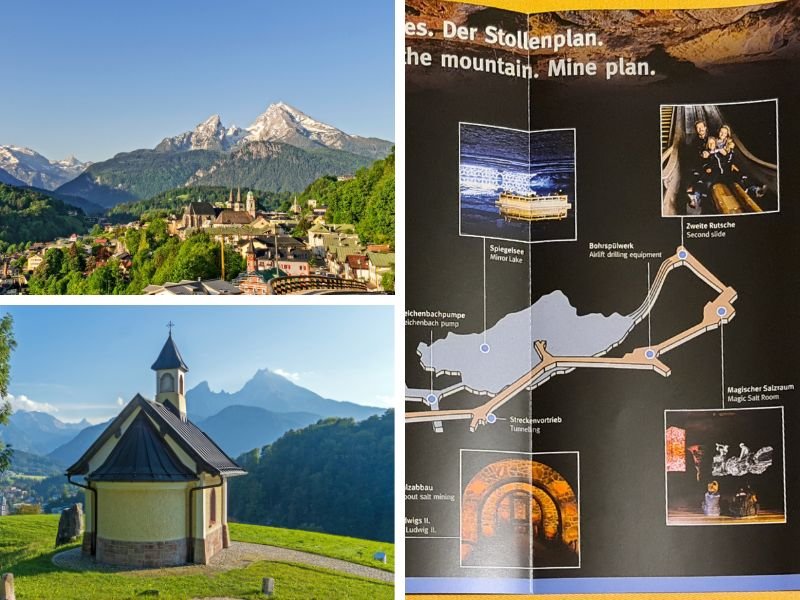
At the eighth day of your 10-day Bavarian adventure, you’ll bid farewell to the charming town of Garmisch-Partenkirchen and set your sights on Berchtesgaden. Despite both towns being nestled in the Bavarian Alps, they are quite a distance apart, with a journey of over two hours by car.
And if you’re relying on public transportation, it’s advisable to leave Garmisch-Partenkirchen early to ensure you have ample time to explore Berchtesgaden, starting with the renowned Salt Mine.
The journey from Garmisch-Partenkirchen to Berchtesgaden by train can take approximately four to five hours, as there are no direct connections. You’ll need to make a stopover in Munich to catch the fastest train to Berchtesgaden.
Once you arrive in Berchtesgaden, you might be tempted to visit Berchtesgaden’s scenic spots like Konigssee, Obersee, and Eagle’s Nest right away. However, it’s best to save these for later as Konigssee and Obersee require a full day to fully appreciate, and Eagle’s Nest is best visited at lunchtime on your last day for a memorable lunch experience.
Instead, upon your arrival in Berchtesgaden, consider visiting the Salt Mine and exploring the Old Town. The Salt Mine, one of the main attractions of Berchtesgaden, offers a fascinating insight into the town’s identity. If time permits after your visit to the Salt Mine, the Royal Castle offers a guided tour that provides further insights into the town’s history.
The highlight of your day, however, will undoubtedly be the Salt Mine, the oldest active salt mine in Germany. Here, you’ll embark on a journey deep into the mountain, transported by a miners’ train, and discover a world of salt 650 meters below the surface.
You’ll encounter a breathtaking salt cathedral and an exciting miner’s slide. The unforgettable boat trip across an underground salt lake and the captivating 3D animations that bring the mining of salt to life make this a truly special experience.
For more ideas about the experience in Berchtesgaden Salt Mine, consider visiting its official website. It’s a wealth of information and provides a glimpse into what you can expect during your visit. To ensure your spot on the tour, it’s a good idea to book your tickets online in advance.
Day 9: Konigssee & Obersee
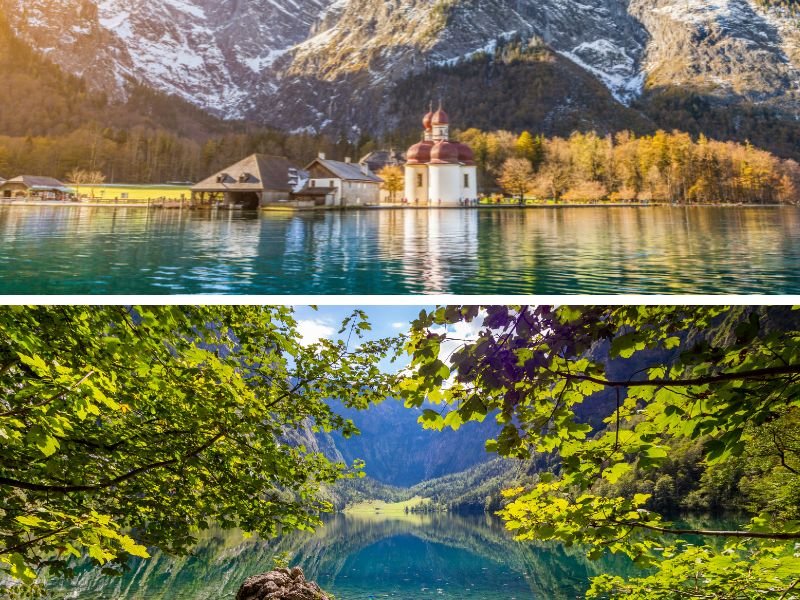
Alright, it’s day 9 of your Bavarian Alps trip. Here’s what you must do: wake up early, if possible, and immediately proceed to Konigssee after your breakfast.
If the weather is in your favor, the appearance of Konigssee will be extremely stunning. The surface of Konigssee would be very calm without the ripples made by the boats, which usually leave the ports by 8:00 am. It acts like a mirror that reflects the image of the mountains surrounding it. While this happens by luck, you’d definitely love it when you see it!
Königssee is nestled in the town of Schönau am Königssee, just to the south of Berchtesgaden. If you’re planning to visit and are using public transportation, there’s a convenient option available. You can take the RVO bus numbers 839, 841, or 843 from the Berchtesgaden bus station. This will get you right to your destination.
In fact, Königssee is known for its clear water and is advertised as the cleanest lake in Germany. Only electric-powered passenger ships, rowing, and pedal boats have been permitted on the lake since 1909. During your visit, you can ride on these boats and explore the lake.
One of the highlights of the boat ride is the Church of Saint Bartholomew. It is the iconic, red-domed church nestled on the shores of the lake. From the boat, you can see this church with the spectacular view of the Watzmann Massif on the backdrop.
The lake is famous for its echo and is one of the few places in the world where you can hear an echo of third order. The boat tour guides will demonstrate this by playing flugelhorn during the trip. Usually, the whole trip to Konigssee (roundtrip boat ride) takes 4 hours to finish but since you’ll be visiting another lake you can expect it to be longer.
From the southern end of the lake (Salet), you can take a short hike to another lake called Obersee which is known for its stunning natural beauty. It is surrounded by steep rock faces. The clear, calm waters reflect the surrounding landscape, creating a mirror-like effect. The beautiful scenery makes Obersee a paradise for photography enthusiasts.
If you find yourself with some extra time at Obersee, consider taking a hike to Rothbach, Germany’s tallest waterfall. The journey there and back is about 2.5 hours. A crucial piece of advice for this adventure: if you’re planning to hike to Rothbach, ensure that you time it right to catch the last boat ride from Salet. And don’t forget to wear appropriate footwear for the hike!
The latest schedule is posted on the official website of Konigssee. There, you can also find the Frequently Asked Questions and Excursion Tips to help you prepare for your visit.
Day 10: Eagle’s Nest & Salzburg
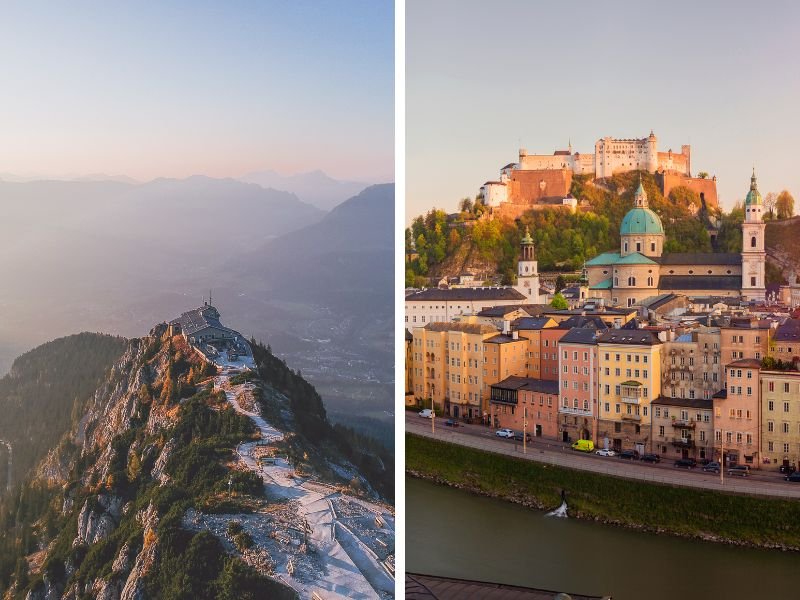
Your 10-day trip to the Bavarian Alps concludes with a visit to the Eagle’s Nest in Berchtesgaden, offering one of the best views of the Bavarian Alps. This is the final tourist attraction in the Bavarian Alps on your itinerary.
After this, you’ll be heading to Salzburg to catch your flight back home. While Munich is another viable exit point from Germany due to its extensive flight connections, Salzburg is closer to Berchtesgaden and therefore more convenient.
Salzburg, one of Austria’s most fascinating cities, is worth spending an additional two or three days exploring! If you want, you can immerse yourself in the rich history of the Prince Archbishops and visit landmarks that served as the backdrop for the movie, The Sound of Music.
If you feel that staying in the city for a few days isn’t feasible, you might want to fit in a short exploring before you leave. This beautiful city offers plenty of opportunities for short walking tours.
The Eagle’s Nest, I believe, is the perfect final destination for your trip. From here, you can get a view that encapsulates your experience in the Bavarian Alps. If the weather permits, you can literally see the mountains, lakes, and culture-filled towns of the Bavarian Alps.
The Eagle’s Nest, perched high atop the Kehlstein peak, is a unique place steeped in history and natural beauty. It was once a retreat for members of the Nazi Party, making it a fascinating destination for those interested in World War II. During your visit, you can gain insights into that period of history and the role the Eagle’s Nest played in it.
Today, the Eagle’s Nest houses a restaurant where you can enjoy a meal on the terrace, surrounded by the stunning alpine landscape.
So, how can you get to the Eagle’s Nest? If you’re already in Berchtesgaden, getting to the Eagle’s Nest is pretty straightforward. First, hop on the RVO-bus 849 at the Berchtesgaden main train station. This bus will take you to the parking area for the Eagle’s Nest in about 15 minutes.
Once you’re at the parking area, you’ll switch to a special bus. These are the only buses allowed on the road up to the Eagle’s Nest. After the bus ride, you’ll walk through a tunnel and then take an elevator. This elevator is quite amazing as it is a brass-lined elevator that goes straight through the mountain right up to the Eagle’s Nest.
For complete visiting information and online booking of tickets, you can check the official website of the Eagle’s Nest.
More Information About Bavarian Alps
If you’re interested in diving deeper into each of the tourist attractions mentioned in this itinerary, or if you’re keen on crafting your own Bavarian Alps itinerary, I recommend checking out my post about the 20 Things to Do in Bavarian Alps.
In that post, I share tips on the best time to visit the Bavarian Alps, suggestions on where to go next, and so much more. It’s a great resource for planning your adventure in the Bavarian Alps.
That’s all for now! I hope you found this post useful. If there’s something on your mind, don’t hesitate to share it in the comment section of this post. I’m eager to hear from you. Here’s wishing you a fantastic trip ahead!
Save it on Pinterest.
